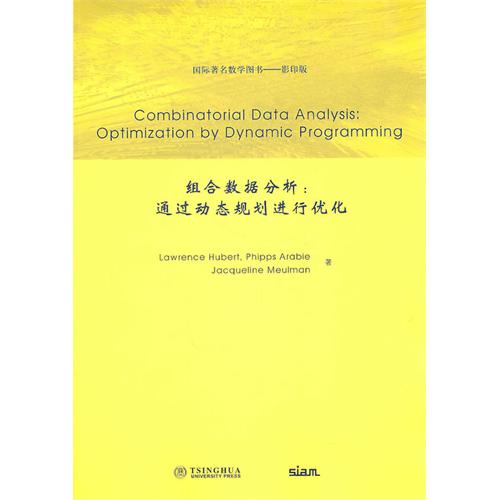《組合數據分析:通過動態規划進行最佳化》是清華大學出版社2011年2月1日出版的書,作者是休伯特。
基本介紹
- 書名:組合數據分析:通過動態規划進行最佳化添加概述
- ISBN:7302245010, 9787302245018
- 出版社:清華大學出版社
- 開本:16
圖書信息,作者簡介,內容簡介,目錄,
圖書信息
出版社: 清華大學出版社; 第1版 (2011年2月1日)
外文書名: Combinatorial Data Analysis:Optimization by Dynamic Programming
叢書名: 國際著名數學圖書·影印版
平裝: 163頁
正文語種: 英語
開本: 16
ISBN: 7302245010, 9787302245018
條形碼: 9787302245018
尺寸: 24.2 x 17.2 x 1 cm
重量: 240 g
作者簡介
作者:(美國)休伯特(Lawrence Hubert) (美國)Phipps Arabie (美國)Jacqueline Meulman
內容簡介
《組合數據分析:通過動態規划進行最佳化》內容簡介:Combinatorial data analysis(CDA)refe rs to a wide class of methods for the study of relevant data sets in which the ar rangement of a collection of objects is absolutely central.Combinatorial Data Analysis:Optimization by Dynamic Programming focu ses on the identification of a rrangements,which a re then fu rther rest ricted to whe re the combinatorial sea rch is ca r ried out by a recu rsive optimization p rocess based on the gene ral principles of dynamic p rog ramming(DP). The authors provide a comprehen sive and self-contained review delineating a very general DP pa radigm,o r schema,that can se rve two functions.Fi rst,the pa radigm can be applied in va riou s special form s to encompass all previously p roposed applications suggested in the classification lite rature.Second,the pa radigm can lead directly to many mo re novel uses.An appendix is included as a user’s manual for a collection of prog ram s available as freeware.
目錄
Preface
1 Introduction
2 General Dynamic Programming Paradigm
2.1 An Introductory Example:Linear Assignment
2.2 The GDPP
3 Cluster Analysis
3.1 Partitioning
3.1.1 Admissibility Restrictions on Partitions
3.1.2 Partitioning Based on Two-Mode Proximity Matrices
3.2 Hierarchical Clustering
3.2.1 Hierarchical Clustering and the Optimal Fitting of Ultrametrics
3.2.2 Constrained Hierarchical Clustering
4 Object Sequencing and Seriation
4.1 Optimal Sequencing of a Single Object Set
4.1.1 Symmetric One-Mode Proximity Matrices
4.1.2 Skew-Symmetric One-Mode Proximity Matrices
4.1.3 TWO-Mode Proximity Matrices
4.1.4 Object Sequencing for Symmetric One-Mode Proximity Matrices Based on the Construction of Optimal Paths
4.2 Sequencing an Object Set Subject to Precedence Constraints
4.3 Construction ofOptimal Ordered Partitions
5 Heuristic Applications of the GDPP
5.1 Cluster Analysis
5.2 Object Sequencing and Seriation
6 Extensions and Generalizations
6 1 Introduction
6.1.1 Multiple Data Sources
6.1.2 Multiple Structures
6.1.3 Uses for the Information in the
6.1.4 A Priori Weights for Objects and/or Proximities
6.2 Prospects
Appendix:Available Programs
Bibliography
Author Index
Subject Index

